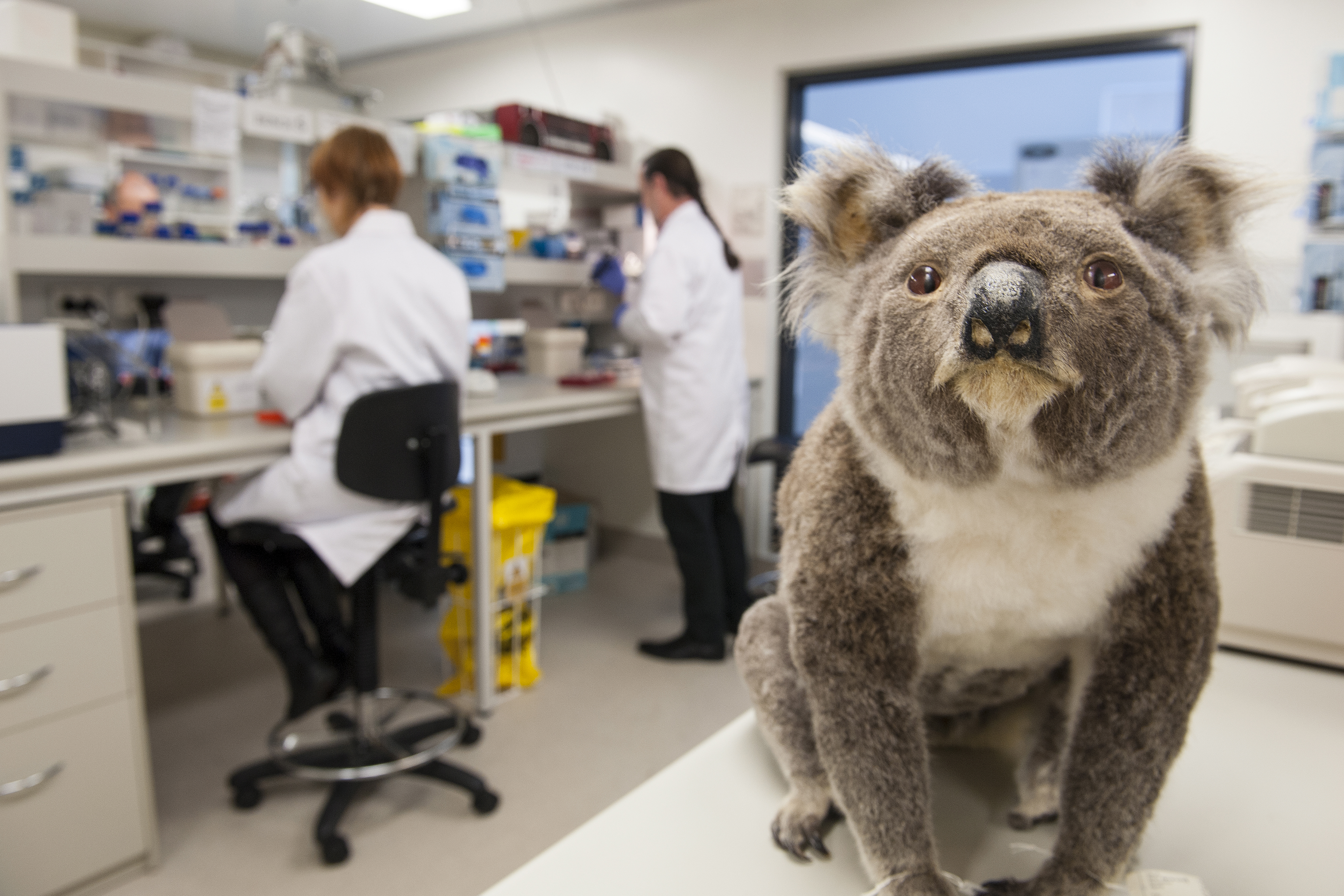An international team of scientists including UConn genomicist Rachel O’Neill have sequenced the first full koala genome, they report today in Nature Genetics. The koala’s genes have already revealed some of the furry tree dweller’s secrets, from how it digests toxic eucalyptus leaves to why it’s susceptible to chlamydia.
Koalas are marsupials, along with kangaroos, wombats, Tasmanian devils, and opossums. Marsupials give birth when their young are still very small and underdeveloped, and then raise the babies in a pouch for several additional months. They diverged from other mammals a very long time ago, and scientists have suspected that the marsupial genome could answer many questions about how early mammals evolved.
“Koalas are an iconic marsupial mammal,” says O’Neill, professor of molecular and cell biology. “Everyone knows what a koala looks like, which makes it a great species to use as an educational tool. But they are at risk due to population crashes in the distant past and an emerging infectious virus.”
Figuring out their genome – spelling out all the genes and which chromosome, or DNA molecule, each gene is on – gives biologists the opportunity to identify genes related to the koala’s response to viruses, and identify boundaries of population diversity that can direct conservation efforts, she says. O’Neill, director of UConn’s Systems Genomics Institute, specializes in marsupials, and was also involved in the first marsupial genome ever sequenced – the tammar wallaby.
The koala genome that has just been published is the most complete marsupial genome sequenced to date, on par with the human genome. The consortium of scientists – 54 researchers from 29 different institutions across seven countries – sequenced more than 26,000 genes in the koala genome, making it slightly larger than the human one. And in one way, says O’Neill, the koala genome is actually better than the human one: the koala genome has had its centromeres defined. Think of the centromere as the spot where the two halves of each chromosome are attached; if you imagine the ‘X’ chromosome, the centromere is at the cross of the X. It’s a special part of the genome that helps the DNA copy itself.
“This is the first full genome assembly in any animal to contain centromeres that have been functionally defined,” O’Neill says. Compared to a human’s, the koala centromeres are small, disordered, and full of ‘jumping genes’, pieces of DNA that can move around within the genome.
Several unusual patterns in the koala genome have already answered questions about the koala that have puzzled people for decades.
For example, koalas live in eucalyptus forests in Australia and subsist almost entirely upon eucalyptus leaves, which contain poisonous compounds that make other mammals sick if eaten in large amounts. Researchers from the Earlham Institute in the UK noticed that the koala genome has a greater number and diversity of genes known to code for metabolic enzymes in the liver that help break down toxins like those found in eucalyptus leaves.
Another important discovery was the composition of koala milk. Because koala babies (called joeys) are born at such an early stage of development – just 5 weeks gestation, compared to the 9 weeks for dogs or 40 weeks for humans – they need very different types and amounts of milk as they grow and suckle inside their mother’s pouch.
“Thanks to the high-quality genome, the team was able to analyze and discover koala-specific milk proteins that are critical for various stages of development, says the University of Sydney’s Katherine Belov, one of the lead authors on the study. It also appears these proteins may have an antimicrobial role, showing activity against a range of bacterial and fungal species, including Chlamydia pecorum, the strain known to cause blindness and infertility in koalas.
Chlamydia has severely reduced koala populations in New South Wales and Queensland. Using information gained from the koala genome, scientists hope to develop a vaccine.
“The genome enables a holistic and scientifically grounded approach to koala conservation,” says Rebecca Johnson, director of the Australian Museum Research Institute and another lead author.
Wild koalas are currently found in eucalyptus forest and woodlands across Eastern Australia (Victoria, New South Wales, and Queensland), and have been translocated to other sites, such as south eastern South Australia and onto some islands.
Their unique and highly specific diet of eucalyptus tree leaves has resulted in koalas being especially vulnerable to habitat loss due to the clearing of native vegetation for agriculture and urban development. The Australian federal government lists koala populations in Queensland, New South Wales, and Australian Capital Territory as ‘vulnerable’ under national environment law. The research team hopes that findings from the koala genome will help efforts to conserve and protect the species.



